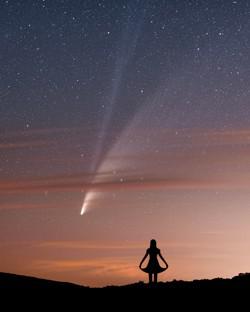Glossary term: 彗星
Description: 彗星是太阳系中的小天体,由不同类型的冰、岩石和尘埃物质混合组成的核——一个“脏雪球”。彗星的核大小可以从几百米到几十公里不等。大多数彗星的轨道是高度椭圆化的。当彗星接近太阳时,部分表面冰层会被蒸发,并被太阳风吹向后方,形成独特的彗发和彗尾。我们之所以能够看到彗星,是因为阳光反射到彗发、彗尾,或者是(对于远离太阳的彗星)彗核上。彗星根据其轨道周期分类,如果其轨道周期已经被多次观测到或已知小于200年,则被分类为“周期彗星”或“短周期彗星”;否则,则被归类为“非周期彗星”。
Related Terms:
See this term in other languages
Term and definition status: The original definition of this term in English have been approved by a research astronomer and a teacher The translation of this term and its definition is still awaiting approval
The OAE Multilingual Glossary is a project of the IAU Office of Astronomy for Education (OAE) in collaboration with the IAU Office of Astronomy Outreach (OAO). The terms and definitions were chosen, written and reviewed by a collective effort from the OAE, the OAE Centers and Nodes, the OAE National Astronomy Education Coordinators (NAECs) and other volunteers. You can find a full list of credits here. All glossary terms and their definitions are released under a Creative Commons CC BY-4.0 license and should be credited to "IAU OAE".
If you notice a factual or translation error in this glossary term or definition then please get in touch.
Related Media
新智彗星的蜕变,作者为斯洛伐克的 Tomáš Slovinský 和 Petr Horálek
Credit: Tomáš Slovinský and Petr Horálek/IAU OAE
License: CC-BY-4.0 Creative Commons 署名 4.0 国际 (CC BY 4.0) icons
彗星 C/2020F3 (Neowise),有分开的尘埃尾和离子气体尾,以及发出绿色光芒的彗发,作者 Dietmar Gutermuth,德国
Credit: Dietmar Gutermuth/IAU OAE
License: CC-BY-4.0 Creative Commons 署名 4.0 国际 (CC BY 4.0) icons
你好,彗星,我们跳舞好吗?作者罗伯特·巴尔萨,斯洛伐克
Credit: 罗伯特·巴尔萨/国际天文学联合会教育办公室
License: CC-BY-4.0 Creative Commons 署名 4.0 国际 (CC BY 4.0) icons
海尔-波普彗星
Credit: E.Kolmhofer, H. Raab; Johannes Kepler Observatory, Linz, Austria credit link
License: CC-BY-SA-3.0 Creative Commons Attribution-ShareAlike 3.0 Unported icons
67P/丘留莫夫-格拉西缅科彗星
Credit: 欧空局/Rosetta/NAVCAM credit link
License: CC-BY-SA-3.0-IGO Creative Commons Attribution-ShareAlike 3.0 IGO icons
Related Activities
Meteoroids, Meteors and Meteorites
astroEDU educational activity (links to astroEDU website) Description: Unveiling the mystery of "shooting stars": meteors, meteorites and meteroids
License: CC-BY-4.0 Creative Commons 署名 4.0 国际 (CC BY 4.0) icons
Tags:
Geology
Age Ranges:
6-8
, 8-10
, 10-12
, 12-14
Education Level:
Middle School
, Primary
Areas of Learning:
Interactive Lecture
Costs:
Low Cost
Duration:
1 hour 30 mins
Group Size:
Group
Skills:
Analysing and interpreting data
, Asking questions
, Communicating information
, Engaging in argument from evidence
Measuring the average speed of a comet
astroEDU educational activity (links to astroEDU website) Description: Using telescope images of comet C/2019 Y4 we calculate its average speed and understand what a physical quantity is
License: CC-BY-4.0 Creative Commons 署名 4.0 国际 (CC BY 4.0) icons
Tags:
Software
, average speed
Age Ranges:
12-14
, 14-16
, 16-19
, 19+
Education Level:
Secondary
Costs:
Free
Duration:
1 hour 30 mins
Group Size:
Group
Skills:
Analysing and interpreting data
, Developing and using models
, Engaging in argument from evidence















